Rear Adm. Philip Sobeck: MSC Needs More Mariners, New Ships
Founded as the Military Sea Transportation Service (MSTS) and renamed Military Sealift Command in 1970, MSC today not only support the Navy, but we are the Department of Defense's provider of all sealift. Maritime Reporter & Engineering News recently interviewed Rear Adm. Philip Sobeck, U.S. Navy, for insights on the service today and it’s needs to grow in the future.
- What makes MSC so vital to the Navy’s fleet and our military forces around the world?
When we look at the history of contested logistics in World War II, for example, all of the operational commander’s after-action reports in the Pacific and Atlantic theaters talked about “logistics, logistics, logistics.” Every senior leader during that timeframe said it was absolutely a war of logistics.
Today, if we have to move forces -- with their vehicles, equipment and material -- from the U.S. to where it’s needed, most of that will move by sea. One of our larger sealift vessels can carry the equivalent of 30 C-17 transports.
Our Combat Logistics Force (CLF) is the key to keeping our ships at sea and in the fight, and sustain our forces engaged in distributed maritime operations (DMO).
MSC currently has 140 ships globally, including ships that are government owned and operated ships, government owned and contract operated, and contract owned and contract operated.
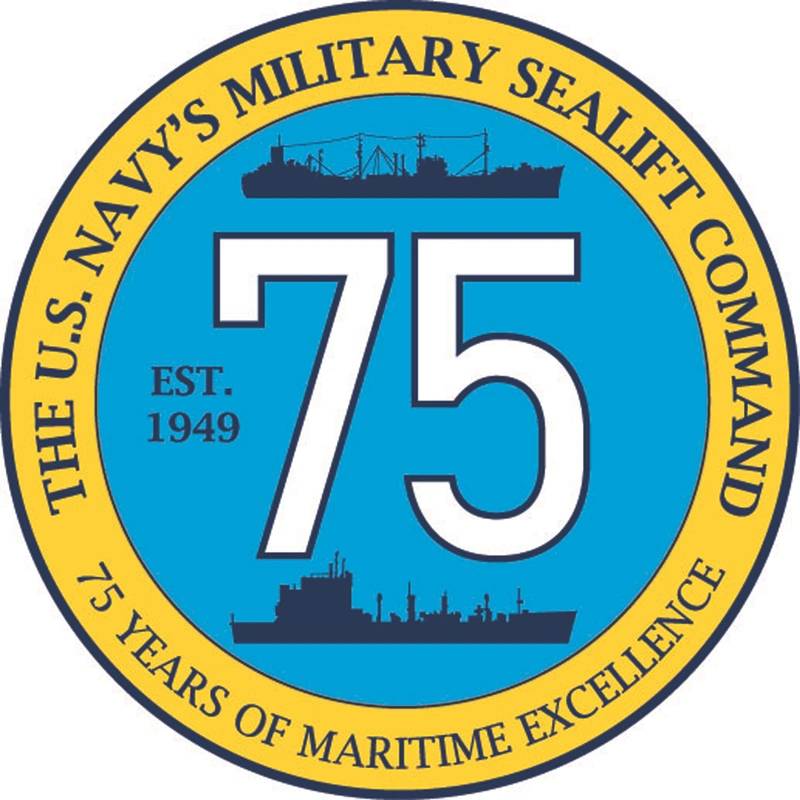 75th Anniversary Logo. Photo by Brian Suriani USN Military Sealift Command
75th Anniversary Logo. Photo by Brian Suriani USN Military Sealift Command
- You not just commanding an operational fleet, you’re running a global business enterprise.
Correct. MSC has responsibilities and authorities that span the entire Navy. I’m a “type commander,” responsible for the “man, train and equip” function that generates forces for the combatant commanders around the world. From the business point of view, I'm an acquisition lead—one of 11 individuals within the Navy. And I’m a contracting authority, also one of just a few within the Navy. We’re our own manning control authority for our civil service mariners (CIVMARs).
- We’re hearing a lot about “contested logistics.” What does that mean?
For years, we have enjoyed intact supply lines and an assured flow of logistics. We cannot assume that luxury in the next major conflict. An adversary will try to deter, delay and stop the flow of logistics, using all means of warfighting, from seabed to cyber to space and everything in between.
Operating our ships in the contested logistics environment is not without risk. We've got to be smart in the disposition of our ships; the way that we maneuver and distribute in a time of our choosing; all so that we can back up, retrograde, and come back and do it again to keep the fight going.
From a global supply chain perspective, we’ve learned a lot about dealing with disruptions. COVID delivered a big wake-up call to the world’s supply chain. Manpower was disrupted; ships were delayed; docks were stacked high with containers; rail terminals were clogged; truckers could get access to the ports.
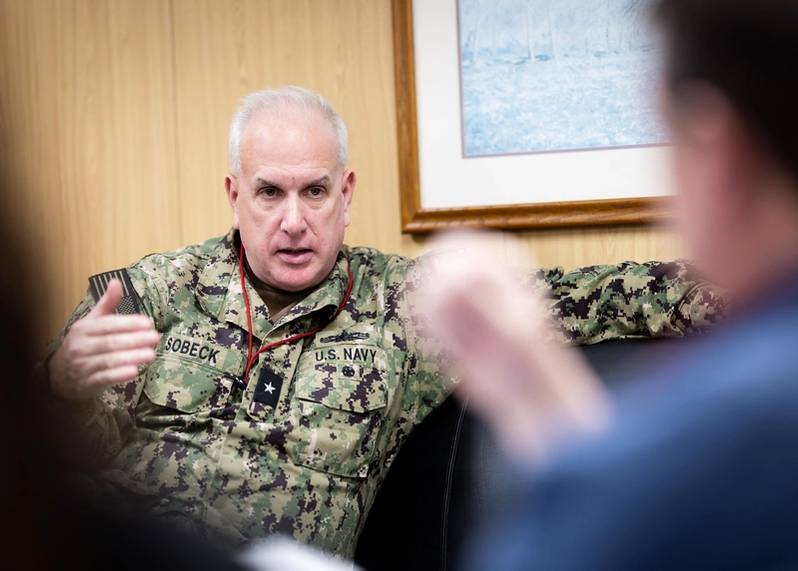 Rear Adm. Philip Sobeck, Commander, United States Navy's Military Sealift Command, visits USNS Patuxent (T-AO 201) for a tour of the ship at Naval Station Norfolk, Va., November 20, 2023. During the tour, Sobeck met with civil service mariners and familiarized himself with the ship. (U.S. Navy photo by Ryan Carter)
Rear Adm. Philip Sobeck, Commander, United States Navy's Military Sealift Command, visits USNS Patuxent (T-AO 201) for a tour of the ship at Naval Station Norfolk, Va., November 20, 2023. During the tour, Sobeck met with civil service mariners and familiarized himself with the ship. (U.S. Navy photo by Ryan Carter)
- The MSC fleet is aging. How do you do all that with old ships while trying to recapitalize the fleet?
To start, we are building new ships. Over the next decade, 12 new classes of ships will come online and MSC will see up to 20 new ships deliver to the fleet in the next five years. This includes new oilers, towing, salvage and rescue tugs, and expeditionary fast transports and emergency medical ships. A large percentage of our ships are 40 years old or older and need to be replaced. We’re talking all the way from steam to diesel and some gas turbines. The commercial world doesn’t use steam any more, but we still have quite a few steam-powered ships. I happen to be a prior enlisted Navy machinist’s mate and a 1200-lb. steam plant qualified engineer, but I can tell you that there are fewer and fewer mariners these days who know steam plants. I can say that we’re expending a lot of resources to allow our older ships to continue to perform.
- You mentioned steam engineers, but you have an across-the-board shortage of CIVMARs to man your ships. How can you keep your ships manned and ready for sea?
Our shortfall is in the middle to senior positions within our licensed mariners, but we need to attract the junior people now, those third-class mariners with the certifications they get from school, and start building our workforce from within.
We need to both recruit and retain today, in order to have the force we need tomorrow. COVID created a lot of uncertainty, and kept us from actively recruiting, and it made everything more difficult because we were constrained from the normal personnel rotations. We are competing with the commercial shipping companies, as well as other jobs that value the skills that our mariners have. We’re not alone in this fight for talent, the entire shipping industry is experiencing a shortage. MSC competes well with the rest of the U.S. maritime industry when it comes to pay and benefits, but there can be issues regarding rotations and time off.
With COVID, we had to make some hard choices for our mariners because we couldn't rotate. Many of our mariners found other employment, and were able to use their skills and their tradecraft in other ways. That had an impact on our workforce. We thought we would have rebounded by now, but many of our mariners have not come back.
We are in that tough period with both recruiting and retention at the same time. It’s a national problem.
We need to ensure our pay and benefits; the predictability of our rotations; and the time off compares favorably with the commercial maritime industry.
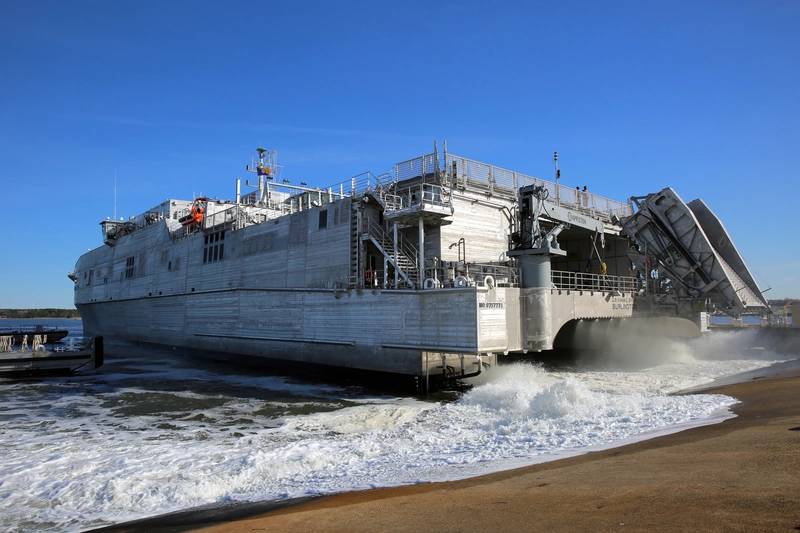 Military Sealift Command’s expeditionary fast transport ship USNS Burlington (T-EPF 10) pulls into Joint Expeditionary Base Little Creek-Fort Story, Feb. 14. USNS Burlington is the U.S. Navy’s newest expeditionary fast transport ship and will be used- transport personnel and equipment in support of a variety of Department of Defense missions. (U.S. Navy photo by Brian Suriani/released)
Military Sealift Command’s expeditionary fast transport ship USNS Burlington (T-EPF 10) pulls into Joint Expeditionary Base Little Creek-Fort Story, Feb. 14. USNS Burlington is the U.S. Navy’s newest expeditionary fast transport ship and will be used- transport personnel and equipment in support of a variety of Department of Defense missions. (U.S. Navy photo by Brian Suriani/released)
- What are some of the programs you have initiated to address the manning issue?
MSC is implementing various initiatives to strengthen the Civil Service Mariner program and improve MSC’s advantage to retain and grow this critical workforce. We have six key initiatives that we started. I was the director of the 21st Century Sailor Office (N17) in my first flag officer job, and involved in building the “MyNavy HR” portal as a mobile, adaptive platform for the management of our active-duty people personnel. So, at MSC, we’ve created a portal--much like MyNavy HR--called “MyMSC” for our CIVMARS. We want our people to be able to track their rotations, and the accrual of leave, management of travel pay, and make available the assignments that are best suited for our people. We can track all of the certifications; Coast Guard licensing; and skill sets across the entire force. A master with an all-tonnage license can pretty much sail on any of our ships and can be detailed world-wide, although some ships like EPF require high-speed craft (HSC) training. So, MyMSC will help track and manage all of those different things in one place. We’re hoping that makes things easier for our people, and that it will help us to retain them. Unfortunately, we can’t guarantee everyone their choice of ship assignment because we just don’t have the mariners.
- The shortage of Mariners is a problem for the entire maritime industry, not just MSC.
That’s right. Our commercial partners that we contract with need mariners, too, and so does the rest of the maritime industry. We're certainly in a situation where we want to maintain positive relations with our partners, but we’re also competing with them for talent.
The U.S. Merchant Marine Academy and state maritime academies are graduating mariners into the workforce. But those graduates have choices. They can go on active duty with the Navy, or sail with commercial companies. As we look to encourage and recruit the next generation, MSC must be an attractive career choice against a backdrop of many other choices.
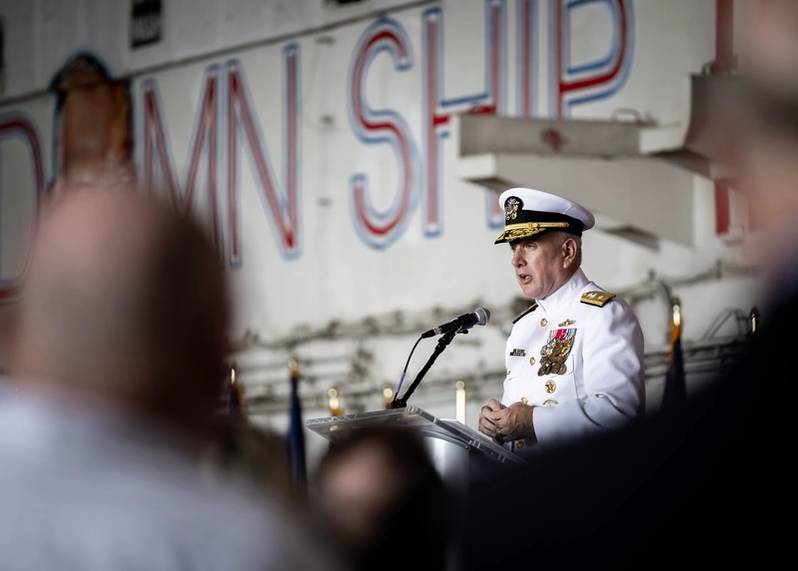 Rear Adm. Philip Sobek, commander, Military Sealift Command (MSC), delivers remarks aboard USS Dwight D. Eisenhower (CVN 69) during MSC’s change of command ceremony held on board the ship, Sept. 8, 2023. (U.S. Navy photo by Ryan Carter)
Rear Adm. Philip Sobek, commander, Military Sealift Command (MSC), delivers remarks aboard USS Dwight D. Eisenhower (CVN 69) during MSC’s change of command ceremony held on board the ship, Sept. 8, 2023. (U.S. Navy photo by Ryan Carter)
- Do your CIVMARs have upward mobility?
The Navy has Sailors who become “Mustangs,” and work their way up to the officers’ ranks, and there’s the Seaman-to-Admiral program to grow young Sailors into future leaders. Likewise, we have a similar program we call “Hawsepipe.” We have people who started on the deckplates who worked their way up the “hawsepipe” from able bodied seaman to master on our ships. We really want to grow our mariners from within. There’s no better place that allows for upward movement for mariners than MSC.
- The Maritime Administration maintains a number of sealift ships in the Ready Reserve Fleet. In a crisis, they can be manned up so MSC can use them to augment your fleet. But, if you took all of those RRF ships and activated them, would we have enough mariners to man them?
Yes. One time. But the problem is sustaining that. We don’t have the reliefs.
That’s my concern if we get into a large-scale, long-term operation. We can be reasonably certain that we won’t have all of our ships going at one time. There will be some sort of prioritization, and we’ll be able to manage that mobilization to some point, but we’re concerned with how we would sustain those ships at sea, and provide for some kind of relief for our people.
- We’ve talked about people. What can you tell us about your fleet?
The Combat Logistics Force will be familiar to our Surface Force Sailors. We have 14 Henry J. Kaiser-class fleet replenishment oilers and three of the new John Lewis class of fleet replenishment oilers, with more on the way. We have 14 Lewis and Clark class dry cargo and ammunition ships that deliver ammo, food, parts and fuel. We have two big fast combat support ships (T-AOEs), that are fast enough to keep up with the carrier strike groups.
The Special Mission ships conduct a number of different missions for a variety of the U.S. military and other U.S. Government agencies. Our missile range instrumentation ship, the USNS Howard O. Lorenzen (T-AGM 25) monitors missile launches and collects data. We have six ocean surveillance ships. Five of them are catamarans that conduct long-range surveillance with their towed arrays, and one is a contract vessel, HOS Red Rock, that can conduct acoustic monitors 24/7 for months at a time. We have six T-AGS oceanographic survey ships that perform a wide range of underwater science, research and surveys, and a pair cable laying and repair ships. Our navigation test support ship USNS Waters (T-AGS 45) helps test the navigation systems on our submarines and submarine-launched missiles. We have the self-propelled platform called Sea Based X-Band Radar (SBX 1), with the giant radome on top, used to track missiles and warheads for the Missile Defense Agency, and it travels with its support ship, the MV Hercules.
For our Service Support ships, we have the two hospital ships, USNS Mercy and Comfort; two rescue and salvage ships; two submarine tenders; and the Sixth Fleet flagship, USS Mount Whitney, that has a combined civil service and military crew. Our two ocean going tugs are going to be part of a 10-ship class. We have a special warfare support ship; two high-speed transports; and the high-speed expeditionary fast transport, of which 14 are now in service. We have contractor-owned ships that are employed for fleet experimentation
Our prepositioning and sea basing ships are loaded with combat vehicles, equipment and supplies at stationed forward at strategic locations in the Pacific and Indian oceans. To support the Marines, we have ten container and roll on/roll off ships, two expeditionary transfer docks (ESDs) and four expeditionary sea base ships. We also have two offshore petroleum distribution system ships that help move fuel ashore. Another ten preposition ships support the Army and Air Force.
It should be pointed out that we can build adaptive force packages to be placed on a number of our ships to add additional capability.
MSC can also lease ship or contract for services as needed. For example, we have five leased tankers deliver petroleum products to our storage and distribution sites around the world. The MSC contracting team and the skill set of contracting in this environment at the at the numbers in which we're contracting, is absolutely going to be critical to how we can project at its speed and scale.
- With all of that, do you have what you need to get the job done?
We’re meeting mission. But we don't have the fleet that we need; we don't have the force that we need; and we certainly don't have the wherewithal to provide all of the end-to-end logistics the force will require in a future major conflict.
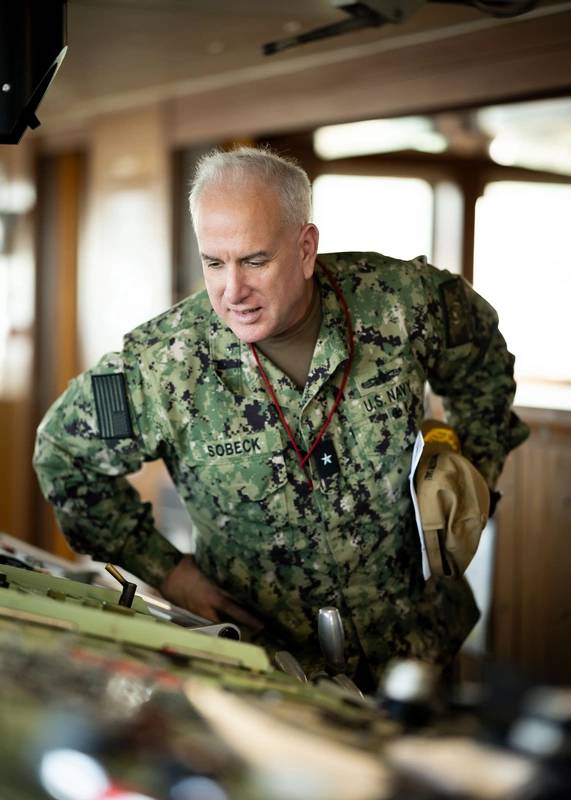 Rear Adm. Philip Sobeck, Commander, United States Navy's Military Sealift Command, visits USNS Patuxent (T-AO 201) for a tour of the ship at Naval Station Norfolk, Va., November 20, 2023. During the tour, Sobeck met with civil service mariners and familiarized himself with the ship. (U.S. Navy photo by Ryan Carter)
Rear Adm. Philip Sobeck, Commander, United States Navy's Military Sealift Command, visits USNS Patuxent (T-AO 201) for a tour of the ship at Naval Station Norfolk, Va., November 20, 2023. During the tour, Sobeck met with civil service mariners and familiarized himself with the ship. (U.S. Navy photo by Ryan Carter)

























